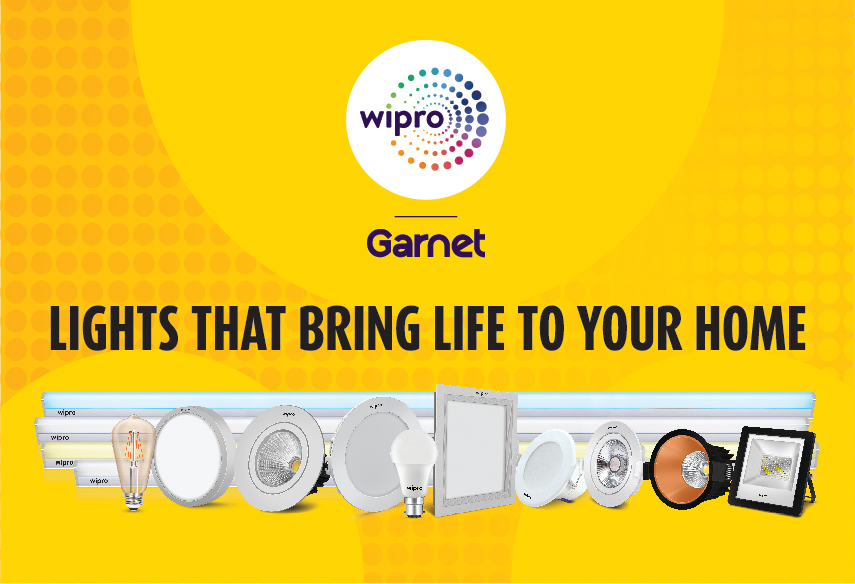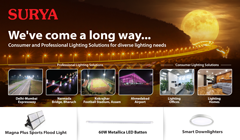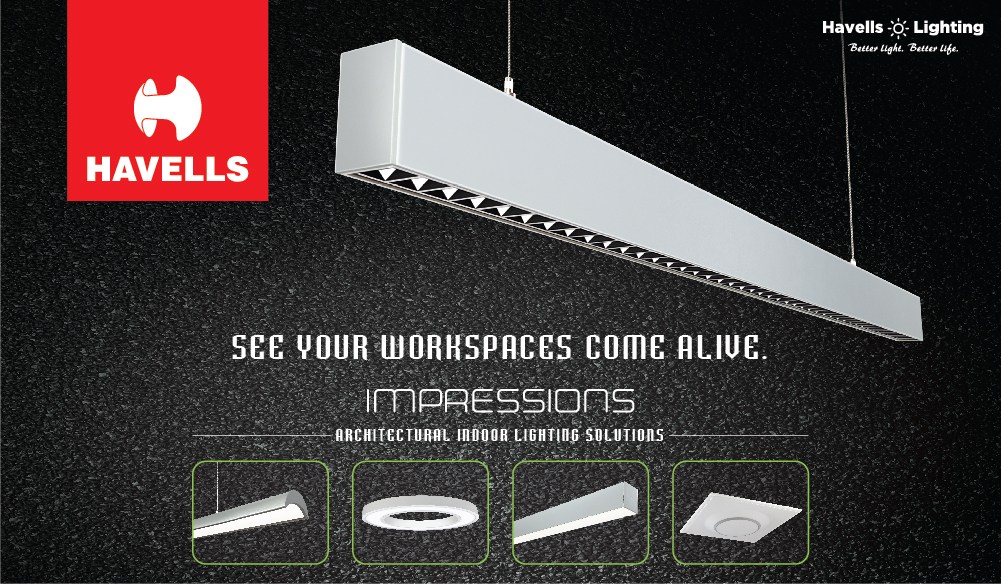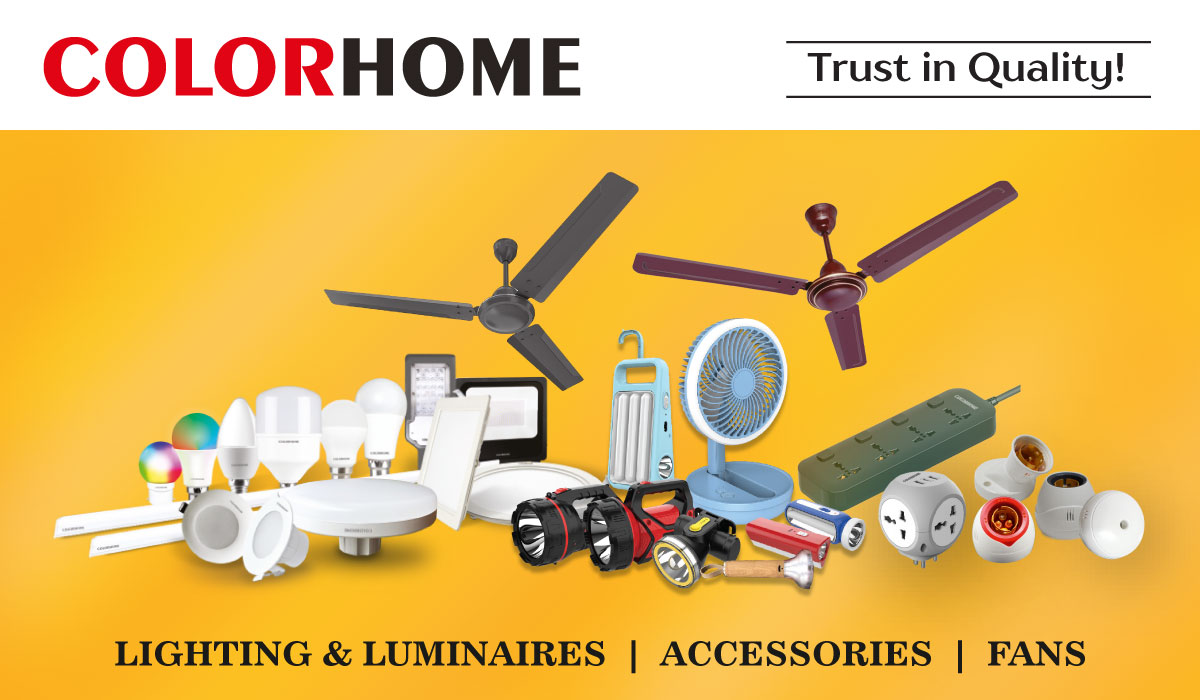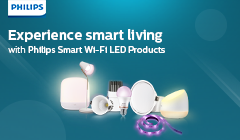Light is so common that it is taken for granted. It is a basic requirement for the visual perception. For the human eye light is a very narrow band of electromagnetic radiation, from 0.38 microns to 0.78 microns. In this narrow range of 0.4 microns the human eye perceives all the colours, ranging from violet around 0.4 microns (or 400 nanometers) to deep red above 0.7 microns (or 700 nanometers) with the colours such as blue, green, yellow, orange and red in between. Sensitivity of the human eye peaks at 0.555 microns and drops to zero below 0.38 microns (termed as the ultraviolet range) and above 0.78 microns (known as the infrared range).
The amount of light produced by a light source is measured in lumens and when one lumen of light uniformly lights up a square metre area, the illumination level is one lux. The quality of light is determined by the distribution of energy over the visible range, i.e. 0.38 to 0.78 microns. One of the important features of light is the way colours are perceived under it. The ability of any light source to bring out the natural colour of objects is rated on scale of 0 to 100, and is referred to as Colour Rendering Index (CRI). Light from incandescent lamps and sun light are able to bring out true colours of objects and their CRI is rated as 100. Many other light sources, particularly discharge lamps, mayor may not bring out true colours of objects.
When a black body is heated to increasingly higher temperature, the light emitted by it changes slow ly from cherry red to white and then to bluish white. Colour temperature of a light source represents the temperature of black body which gives the same overall colour impression as that of the light source. Colour temperature of commonly used light sources range from 2700″K for a GLS lamp to 6500″ K for the cool day light Fluorescent Lamp.
All electric lamps could be broadly classified into two categories : Incandescent and Discharge. In an incandescent lamp a tungsten filament is sealed in vacuum or inert atmosphere and heated to high temperature by passage of electric current and the hot filament emits light. In a discharge lamp, current is passed through a gas sealed in a tube and the gas atoms emit their characteristic radiation in the visible range and also outside the visible range. In a fluorescent lamp, the emitted radiation is predominantly ultra violet which is converted into visible light by a phosphor coating inside the tube.
Incandescent lamps can be grouped into vacuum lamps and gas filled lamps, and the latter is further classified into halogen and non-halogen lamps. Discharge lamps can be grouped into low pressure discharge lamps (such as fluorescent lamps – FTL) and high pressure discharge (HID) lamps (such as high pressure mercury, high pressure sodium, metal hillide etc). HID Lamps are commonly used for out door applications, such as street lighting, while FTL and incandescent (GLS – General Lighting Service) lamps are more commonly used for indoor lighting. Efficacy of an electric lamp is expressed in terms of the amount of light (lumens) it produces for each unit of power (watt) and is expressed as lumen/watt. In general, discharge lamps are significantly more energy efficient as compared to incandescent lamps.
Light Sources – Future Trends
The business of Energy Efficiency has become one of the most important issues of the century to curb the greenhouse gases to tackle the global climate changes. Inspite of fast track power projects etc., the power crisis in the country is worsening by the day
The lighting load in the country was approximately 18% of the total connected load which was approximately 100000 MW by the year 2000 against an average lighting load of approximately 8-10% worldwide with ELCOMA’s Vision 2020 it was planned to reduce Lighting Consumption to less than 13% by introducing energy efficient LED Lighting. The success of this plan saved more than 47000 MW of power by year 2020. The solution therefore lies in the Demand Sale Management (DSM), which is a continuous process
Compact Fluorescent Lamps (CFLs):
Although it is difficult to visualise the world without the common incandescent GLS bulb in spite of its being grossly inefficient and short life, the ever increasing energy costs and the growing environment concerns will force the changeover to CFLs because these save upto 80% on electricity when compared to ordinary incandescent GLS bulbs for the same light output. For example a20W CFL will replace a lOOW incandescent GLS bulb resulting in 80% saving in electricity bills.
Moreover CFLs have longer life of 12000 burning hours against less than 1000 burning hours for the ordinary incandescent bulb. Because of very long life of CFL far fewer lamps are required with further savings in power, raw material and transport.
The CFL are easy to install because the lamps with the integral retrofit Electronic Ballast have the same cap as the incandescent GLS bulb.
Fluorescent Tubes:
The growth in the Fluorescent lamps will and must continue but the emphasis must shift to energy efficient Triphosphor lamps of lesser diameter. Indeed in other parts of the world the 40W Fluorescent lamps of 38mm diameter became obsolete in the early 1980’s. India also must follow the International trend because the advantages ofthe slim line Triphosphor lamps over the 40W 3 8mm tubes are many.
First and foremost the Triphosphor lamps are 50% to 60% more energy efficient. Against 290 gms. of glass used for the conventional40W tube, the new generation of lamps use much less for example only 183 gms for 36W 26mm (T8) lamp and only 100 gms. for the 28W 16 mm (T5) lamp resulting in significant savings in energy and raw materials in glass production. Also the Triphosphor lamps bave lumens depreciation of less than 5% even after 18,000 burning hours. Diversity of colour temperature of these lamps permit tailor made solutions for a variety of applications.
The modern Triphosphor lamps have a life of over 20000 burning hours against only 5000 burning hours ofthe conventional40W tubes and therefore greatly reducing the quantity of replacement lamps resulting in enormous savings in raw materials, energy and transport and recurring costs to the consumer.
Electronic Control Gear (ECG):
Increasing energy and maintenance cost and serious concerns in respect of safety, is resulting in growing realisation that the ECG must replace the conventional Electro Magnetic Copper/Aluminum Ballast. Indeed in some countries the use of Electro Magnetic Ballast is no longer permitted.
In the near distant future we expect and hope that the use of ECG will be made mandatory in high rise buildings, schools, cinemas, hospitals, hotels and public places where large number of people are likely to congregate for reasons of safety and minimising the fire hazard.
The major advantages of ECG are:
- Greater fire protection because lamp operates at lower temperature and automatic shut down of defective lamp.
- Operation at very high frequency (25-40 KHZ) ensures smooth, flicker free light with no stroboscopic effect.
- High power factor> 0.92.
High Intensity Discharge Lamps:
The trend here will be improvement in energy efficiency, luminous efficacy, colour rendering and compactness. With times, standard HPSV lamps will be replaced by NAV Super I SON Plus with excellent luminous efficacy particularly for street lighting and flood lighting where colour is not an important factor.
In case of the Metal Halide Lamps improvements are taking. place progressively in terms of their photometric properties such as luminous efficacy, their colour rendering and their constant colour throughout their entire life, low thermal output and long life.
The Metal Halide Lamps are also becoming more and more compact, making them ideal for indoor lighting, sales areas, shop windows, hotels, restaurants, offices and outdoor lighting such as lighting of buildings and monuments.
Higher wattage Metal Halide Lamps have become a standard for sports stadiums, flood light systems, solar simulation etc. Indeed, we should see an enormous growth for Metal Halide in the next decade.
Automotive Lamps:
The car manufacturers have long wanted their headlights to be more and more compact while at the same time producing even more light. Conventional car Lamp technology was simply unable to meet these requirements. The latest type ZENARC high pressure gas discharge lamp based on xenon is likely to revolutionise the headlights in the 21st Century.
The use of neon, inert gas which gives out a red light when energised by an electric field in miniaturised tubes in a variety of shapes, will give a new freedom of expression to designers and stylists of Automobiles. Also in 21st Century we will witness ever increasing use of Fibre Optics in Automotive Lighting.
LED Lamps:
The Light Emitting Diode (LED Lamp) has changed the complete scenario in the Lighting concepts and applications. LED in the most versatile Light source that can be used for any Lighting application.
By year 2024, The conventional Lighting will remain less than 7 to 8%, as LED will take over all the applications.
All lamps are generally operated inside a fitting or a luminaire which directs the light in the desired fashion. The overall efficiency of a lighting system is dependent on the efficacy of the lamps and luminaries combination.
Comparison of Various Light Sources
| Type of Lamp | Luminous Efficacy (lm/W) | Colour Rendition Properties | Remarks |
|---|---|---|---|
| Incandescent | 10-15 Im/W | Excellent | Due to poor luminous efficiency, it has restricted use |
| Halogen | 17-33 Im/W | Excellent | Used in flood lighting installations and in projectors & motorcar headlamps. |
| Fluorescent | 65 Im/W | Good-depending on the fluorescent coating | Popular for indoor lighting. |
| Compact Fluorescent | 55-65 Im/W | Very good | Tremendous potential for energy savings. |
| High Pressure Mercury Vapour | 58 lm/W | Fair | Streetlighting, highway lighting |
| Metal Halide | 90 Im/W | Excellent | High luminous efficiency. |
| High Pressure Sodium Vapour | 145 lm/W | Fair | Suitable when colour rendering is not important. |
| Low Sodium Vapour Pressure | 200 Im/W | Poor | Energy saving but poor colour rendition |
| Induction Lamp | 65-70 lm/W | Excellent | Due to extremely long life, ideal for use in installation where relamping and maintenance are difficult or expensive. |
| LED Lamp | 90-120 lm/W | Excellent | Long life and very affordable |


